statua urbana publications
in Portuguese
Soares, Ana Paula Gil
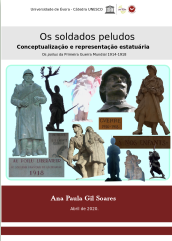
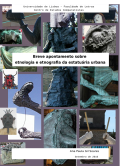
2016 - Breve apontamento sobre etnologia e etnografia comparada da estatuária urbana
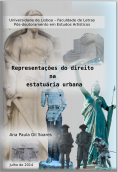
2014 - Representações do direito na estatuária urbana

2013 - Património imaterial e estatuária urbana
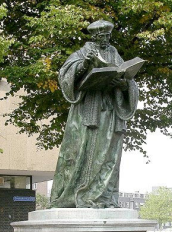
2012 - A estatuária e a escultura figurativa urbana:conceptualização de estatuária no espaço urbano
about urban statuary
1. What is urban statuary?
2. Contemporary production
3. Urban statuary and cultural heritage (tangible and intangible).
4. Application of Urban Statuary to UNESCO's notions of tangible and intangible cultural heritage.
5. How to classify? Typology of pieces of great material value and documentary and plastic value. Target audience: associations, community members, schools, local authorities, researchers;
Smithsonian Institution - Smithsonian Institution Research Information System [E.U.A],http://www.siris.si.edu. juik

1. What is urban statuary?
This field research covers a significant part of Western Europe and some territories in Central Europe. In 2009, it was already observed that around 71% of the works from the different European territories were from the twentieth and twenty-first centuries, clear evidence of the contemporaneity of this artistic medium for the semanticization and aestheticization of urban space.
The term statue, from the Latin statua, which best describes the thousands of figurative sculptures in European urban spaces, has not always been peacefully accepted or enthusiastically embraced. Through a comparative semantic study of the concept of "urban statuary" in several languages of the Indo-European family and the analysis of several works of statuary installed in urban outdoor spaces, we can see that the statuary of the 20th and 21st centuries, although distancing itself from the models of 19th century sculpture, continues to include in its representations some semantic traits that now identify it as a genre clearly differentiated from other forms of sculptural creation (Soares, 2012).
The concept of “statue”, which derives from the Latin etymon statua, is used in reference to the figurative sculptural representation of illustrious personalities, and the semantic trait that is the sense of verticality of the figurative representation appears associated with the sense of homage and memory of the community where the work is implanted due to the ties that it evokes with the place. In fact, the genre statuary (Rodrigues, Francisco de Assis, 1875), which defines the three-dimensional representation of the image of the human figure or of animals or of gods or demigods, more or less anthropomorphic or zoomorphic, presents the root common to Indo-European languages *stā- ‘stand’, which coins the prototypical notion of the concept that is the sense of verticality associated with the Latin item statua. In fact, Pokorny's own etymological dictionary of Indo-European confirms this thesis “stehend, wie stel- zu stä- ,stehen'” (cf. Pokorny, 1959).
For all languages originating in Latin, the Latin etymon statua is the origin of the terms “statue” and “statuary”, statuarius in Latin. The meaning of statua points to “sculpted three-dimensional image or figure” and statuarius to “art of sculpture”. This is the case of the terms for Portuguese – statue and statuária; Spanish – estatua and estatuaria; French – statue and statuaire; Italian – statua and statuaria; English – statue and statuary.
For all languages originating in Latin, the Latin etymon statua is the origin of the terms “statue” and “statuary”, statuarius in Latin. The meaning of statua points to “sculpted three-dimensional image or figure” and statuarius to “art of sculpture”. This is the case of the terms for Portuguese – statue and statuária; Spanish – estatua and estatuaria; French – statue and statuaire; Italian – statua and statuaria; English – statue and statuary. In other languages of the Indo-European family, namely those of Germanic origin, in addition to the terms with the Latin etymon statua and statuarius, we find other morphologically complex lexical items, composed of terms that denote the prototypical sense of verticality of the concept, i.e. “stand-“, and the term “image”, i.e. “-bild”. Thus, in German we note Standbild, Statue and Bildhauerei; in Dutch standbeeld, Statue and beeldhouwkunst; in Danish statue and billedhuggerkunst; in Swedish staty and bildhuggeri.
O mesmo significado verifica-se no grego em άγαλµα e αγάλµατα. Com origem no grego antigo, o termo άγαλµα, com o sufixo -µα, significa estátua a partir do étimo άγαλ- que significa “homenagear”.
Ilustramos na tabela seguinte uma síntese do estudo comparado da semântica dos termos “estatuária”, “estátua” e “escultura” em várias línguas da família do Indo-Europeu (Soares, 2012: 29):
porestatuária
estátua
escultura
spa
estatuaria
estatua
escultura
fra
statuaire
statue
sculpture
ita
statuaria
statua
scultura
deu
Bildhauerei; Plastik
Statue; Standbild
Skulptur;
dan
billedhuggerkunst
statue
skulptur,
swe
bildhuggeri
staty
skulptur; skulptut
nld
beeldhouwkunst beeld(houw)werk
standbeeld
beeldhouwen
eng
statuary
statue
sculpture;
ces
plastika
socha
skulptura, sochařství, socha
rus
Скульптура; ваяние
статуя
Скульптура
ваяние
ell
αγάλματα
άγαλμα
Άγαλμα; γλυπτική,
Fig. 1 – Estudo comparado da semântica dos termos estatuária, estátua e escultura.
Concluímos através da investigação semântica comparada dos conceitos de estátua e estatuária nas línguas da família do Indo-Europeu que a estatuária é uma forma de arte que se insere no género supraordenado da escultura figurativa. A arte da estatuária é cunhada na base da noção de estátua, a qual contém todos os traços semânticos que a descrevem como a representação de uma figura com características do mundo das entidades animadas, na forma tridimensional, e que aparenta um grau elevado de verosimilhança visual com a entidade representada. Outro traço distintivo desta arte de representação figurativa tridimensional é a ideia de valor civilizacional que lhe está associada. A investigação semântica diacrónica que elaborámos (Soares, 2012) demonstra que a estatuária delimita a sua actuação à figuração de personalidades, tais como homens famosos, divindades, animais e personalidades em associação com animais, tais como figuras a cavalo, e trabalhos ou actividades consideradas distintas. As figurações podem apresentar-se de vulto completo ou apenas apresentar um troço do corpo humano como, por exemplo, um busto, uma cabeça ou um tronco. Em todas as definições que estudámos existe uma nota predominante que é a semelhança da forma com a imagem da figura representada e a contemplação e admiração a que se presta a estátua implantada, sobretudo ao ar livre, sendo que as estátuas são erguidas como prova de homenagem e como valor de memória. Através de consulta bibliográfica diversa sobre estatuária, notámos que é comum a classificação desta forma de arte no espaço exterior numa corrente neo-académica e que este epíteto denota algum tom depreciativo. Quase como se fosse inevitável contrariar o academismo do Renascimento ou da Antiguidade Grega e Romana. Assim, para além do epíteto "neo-académico" encontramos também com frequência a classificação "naturalista" para assinalar a estatuária urbana que tem emergido no espaço ao ar livre das aldeias, vilas e cidades ao longo do século XX e no século XXI. Por exemplo, em Gonçalves (1986) é mencionada a procura em "contrariar o academismo" quando se aponta a encomenda de escultura do Estado Novo; Matias (1986: 135) refere a tendência naturalista na escultura que, de uma forma incomparável, integrou "o ensino clássico tradicional em obras [...] de grande qualidade e originalidade". Mas também em publicações estrangeiras (em suporte papel e online), notamos que a estatuária carece de apoios para o seu estudo, desenvolvimento e classificação, e que impulsionem a própria divulgação da obra, a qual tem sofrido um grande incremento a partir da segunda metade do século XX. Caspar (2003 e 2004) nomeia no título das suas obras sobre estatuária de Berlim os tipos representados e os materiais. Em Caspar (2003), Marmor, Stein und Bronze. Berliner Denkmalgeschichten, são referidos os materiais – mármore, pedra e bronze – no título para contar a história dos monumentos históricos de Berlim, desde figuras da mitologia (deusa da vitória ou a Quadriga), personalidades (académicos e escritores como Humboldt ou Brecht, militares como Friedrich der Groβe), simbologia da cidade (o urso de Berlim ou o Roland), monumentos militares (memorial soviético como sowjetisches Ehrenmal), etc. Caspar (2004). Fürsten, Helden, groβe Geister. Denkmalgeschichten aus der Mark Brandenburg, é dedicado exclusivamente ao Estado de Brandenburg e às figuras que contam a sua história, ou seja, os seus príncipes e heróis (monarcas e generais). De facto, verificamos que tem emergido nos anos recentes o interesse em vários países pelo levantamento e observação desta forma de arte, sinalizando um espaço para estudos mais aprofundados que mostrem a importância da arte da estatuária urbana. Alguns levantamentos estão alojados em sítios Internet de edilidades locais, outros em instituições académicas ou instituições que se dedicam à museologia, e outros têm na sua origem páginas pessoais individuais. Indicamos de seguida alguns desses sistemas, bases de dados, colecções, referências, com alguns apontamentos nos casos que nos pareceram relevantes.
Smithsonian Institution - Smithsonian Institution Research Information System [E.U.A],http://www.siris.si.edu.about this website
Php pagination script - thanks to phppot, https://phppot.com
Learn to Code and documentation about html, css, php, mysql, javascript - thanks to w3schools, https://www.w3schools.com
Webdesign and Coding - João filipe Vieira
All photos and field notations were taken directly at the sculptures location.
field notations - Ana Paula Gil Soares
photos - João Filipe Vieira
infographics
Some infographics created to better conceptualize the theme, included in various works.
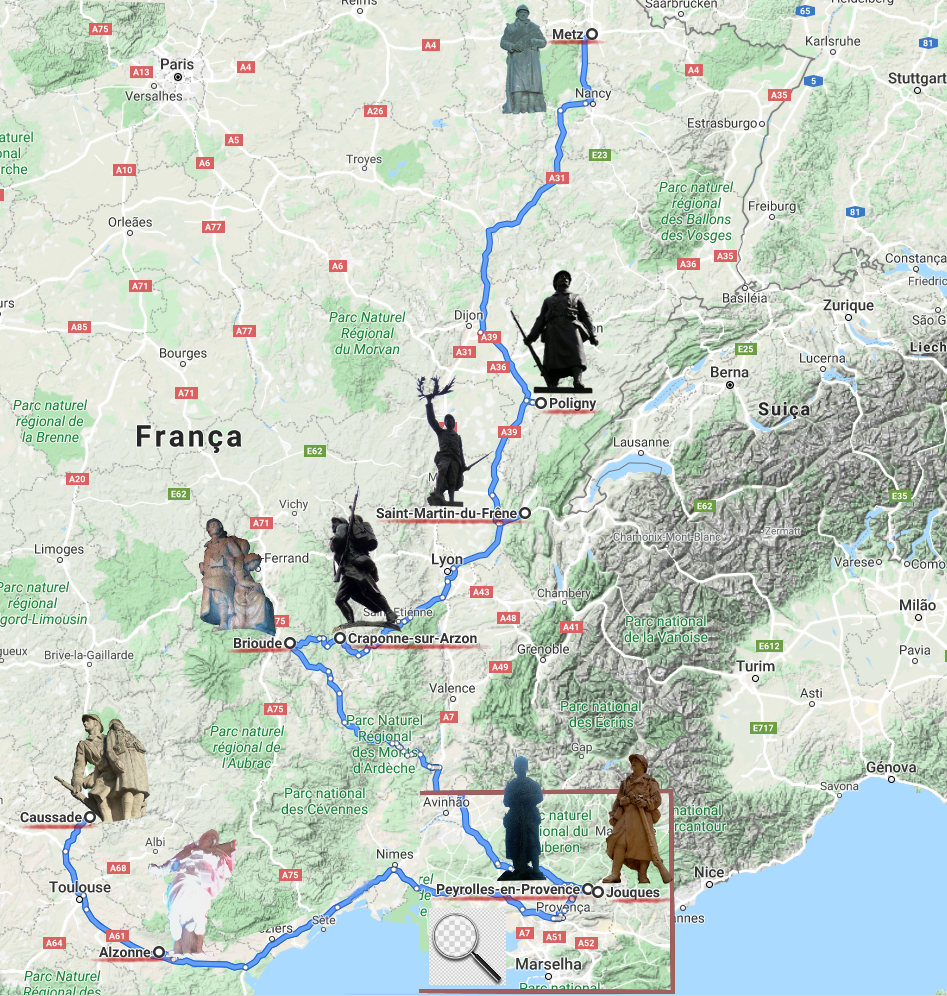
The image above shows the geographical placement of different types of "poilus" in French territory, along the marked route. Conceptualização e representação estatuária dos soldados peludos in the work: "Os poilus da Primeira Guerra Mundial 1914-1918"
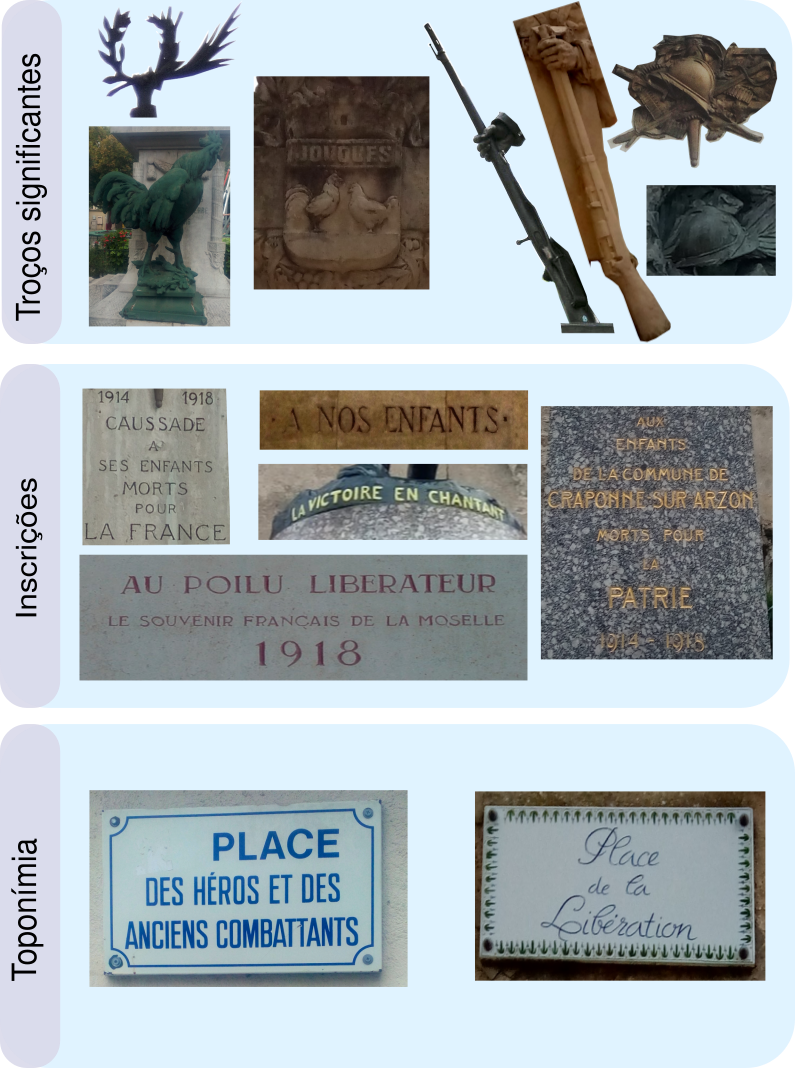
In this case, it is a comparison between excerpts of attributes, inscriptions and toponymy. In the same previous work.
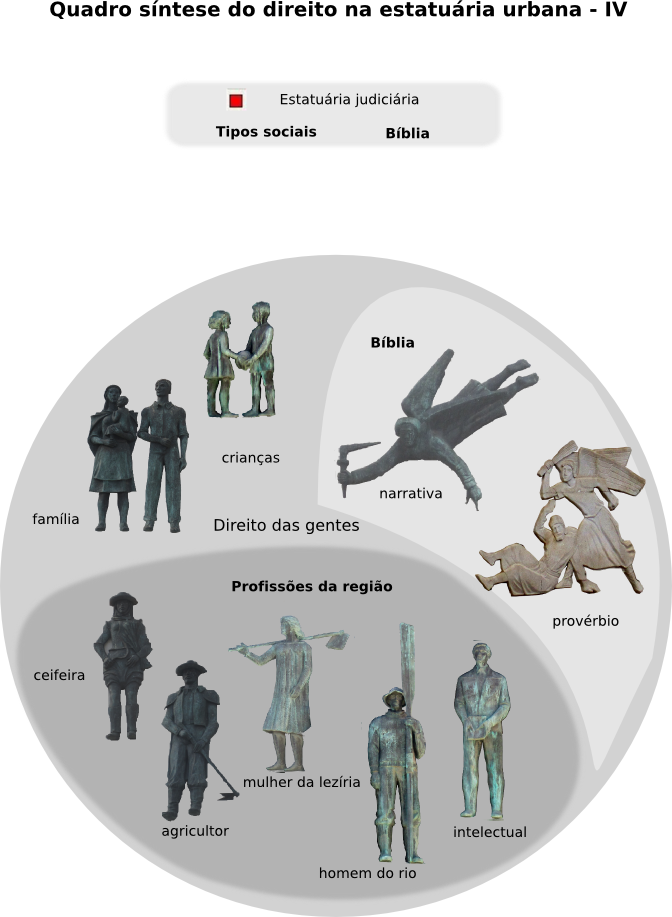
In this case, we are dealing with the social and religious types present in judicial statuary in Portugal, in the work "Representações do direito na estatuária urbana".
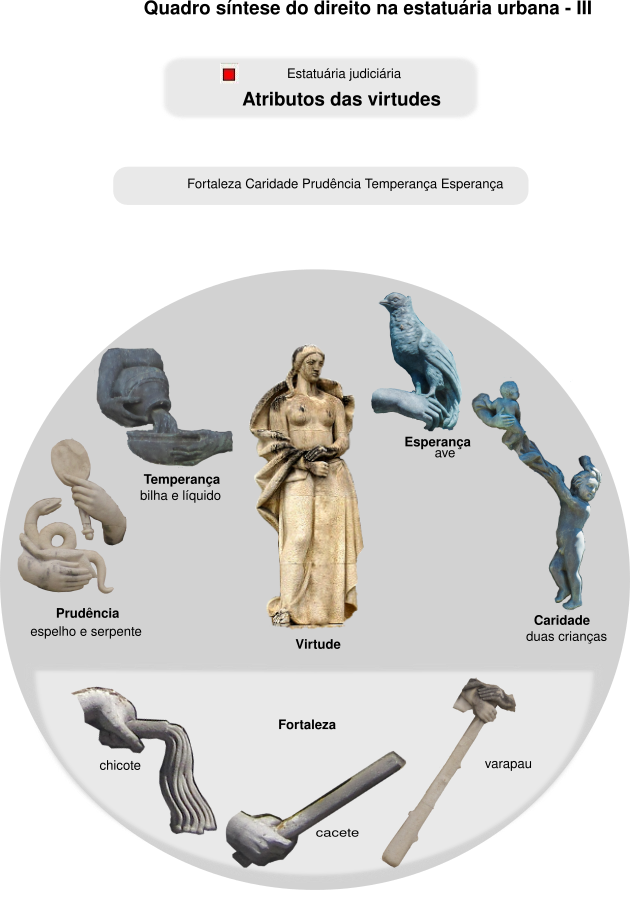
In this case, also coming from Portuguese judicial statutes, the attributes of virtues can be observed.